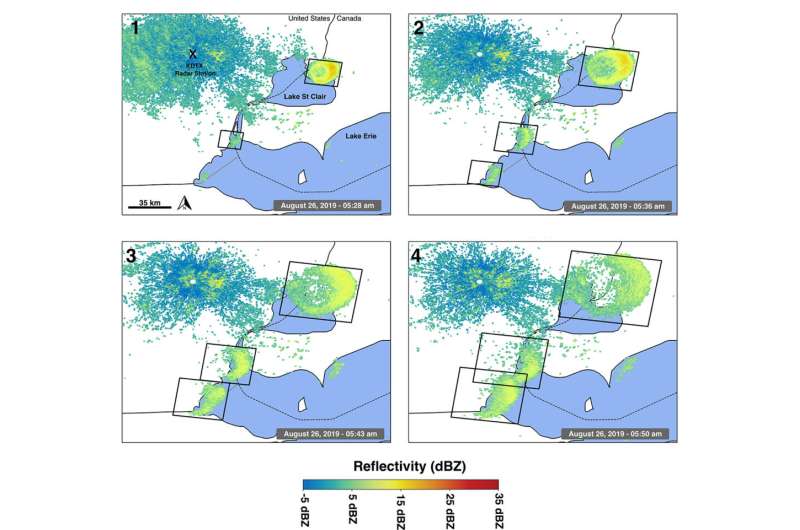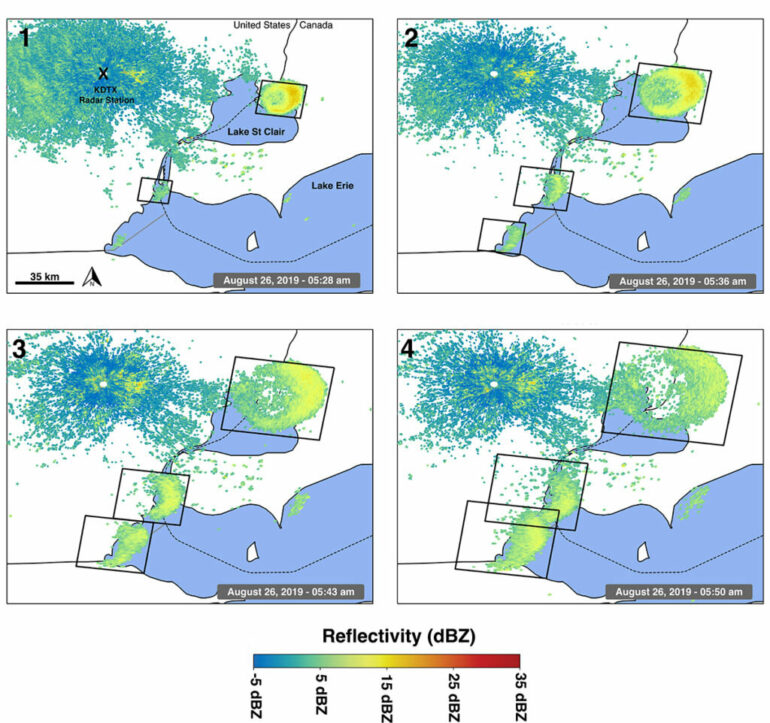Birds including swallows and martins—known as aerial insectivores—control insect populations and insect-borne disease and provide hundreds of millions of dollars’ worth of pest control for agriculture. But these feathered friends to humanity are declining at an alarming rate, with species in North America declining more than 30% from 1970 to 2017.
Two recent Colorado State University studies out of the Warner College of Natural Resources used weather radar to track the movements of aerial insectivores and explore how their patterns have changed over the past 20 years. They examined changes in the birds’ roosting habits to try to determine why the species are declining.
Prior to migration, aerial insectivores gather in roosts that may contain thousands to hundreds of thousands of birds. The studies used 21 years of data from 12 weather surveillance radar stations in the Great Lakes region and found that peak and late roosting stages are shifting earlier in the season, following the long-term trend of warmer temperatures.
“The communal roosting behavior of swallows and martins is an important part of their survival strategy,” said Maria Tiburcio Dias Belotti, a Ph.D. student in fish, wildlife and conservation biology and an author of both papers. “Understanding what is driving changes of this behavior throughout the years is likely to help us figure out why these species have been facing declines and what we can do to stabilize their populations.”
Adapting to their environment
Plants and insects are emerging earlier in the season due to climate change. This shift in resource availability, or some other climate signal, is likely leading to the earlier roosting and migration patterns, which could have health implications for the birds.
“Our results showed that this shift could lead to a shortened pre-migratory roosting season, which could mean that birds have less time to fuel up for the upcoming migration,” said Yuting Deng, a Ph.D. student in fish, wildlife and conservation biology and an author of both papers. “That may cascade to a lower chance of survival during fall migration or worse body condition when they reach the wintering ground.”
The study led by Deng and published in Global Change Biology found the timing of peak roosting activity is now 4.5 days earlier than it was two decades ago, but the timing of roosting stages earlier in the season was largely unaffected.
New technique
The studies were the first to apply machine learning to filter massive amounts of long-term weather surveillance radar data to monitor large-scale aerial insectivore behavior. This is the first time these species’ responses to environmental change have been studied at such a broad scale over such a long period of time.
Weather radar enabled the scientists to estimate the number of birds within each roost as well as seasonal changes. Weather radar data is beneficial in its consistency, compared to former methods like periodic human observation.
This new method brought together multiple disciplines.
“Both papers are great examples of highly interdisciplinary work that crosses ecology, remote sensing and computer science,” said Kyle Horton, assistant professor of fish, wildlife and conservation biology and an author of both papers.

This figure shows the dispersal of hundreds of thousands of swallows and martins from the shores of Lake Erie and Lake Saint Clair, as captured by radar. The three roosts highlighted in black boxes were observed every year from 2000 to 2020. Higher values of reflectivity (measured in dBZ) indicate higher density of birds. © Maria Tiburcio Dias Belotti
Birds of a feather roost together
While enormous gatherings of birds numbering in the hundreds of thousands are impossible to ignore, the second study, led by Belotti and published in Remote Sensing in Ecology and Conservation, found that small roosts are more common than large roosts.
“The larger roosts may drive our attention and fascination as birdwatchers, but it seems like the smaller roosts could have an equally important role in the overall roosting dynamics,” Belotti said.
Researchers also found that large roosts recur in the same locations year after year—up to the full 21 years covered by the study—whereas small roosts are less consistent. They hope that better understanding these patterns and monitoring population size will help inform conservation measures.
More information:
Yuting Deng et al, Quantifying long‐term phenological patterns of aerial insectivores roosting in the Great Lakes region using weather surveillance radar, Global Change Biology (2022). DOI: 10.1111/gcb.16509
Maria Carolina T. D. Belotti et al, Long‐term analysis of persistence and size of swallow and martin roosts in the US Great Lakes, Remote Sensing in Ecology and Conservation (2023). DOI: 10.1002/rse2.323
Provided by
Colorado State University
Citation:
Weather radar, machine learning used to study how bird roosting habits are changing with climate (2023, January 27)



